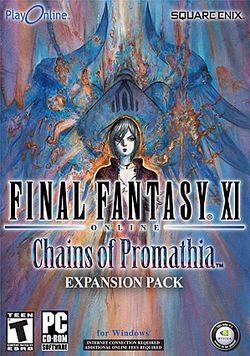
| Final Fantasy XI: Chains of Promathia | |
|---|---|
| Developer(s) | Square Enix |
| Publisher(s) | Square Enix |
| Year released | 2004 |
| System(s) | Windows, PlayStation 2, Xbox 360 |
| Preceded by | Final Fantasy XI: Rise of the Zilart |
| Series | Final Fantasy |
| Genre(s) | RPG |
|---|---|
| Players | MMOG |
| Modes | MMOG |
| Rating(s) |
Launched in fall 2004, Final Fantasy XI: Chains of Promathia is the second expansion pack to Final Fantasy XI.
Added many new areas around the world, five new Regions, and ushered in many changes to game sub-systems. In addition, an extensive new storyline was added in the form of missions, quests, and a new BCNM type battlefield arenas known as Empty Notorious Monster (ENM) battles.
Story[edit]
While Altana soars on wings of freedom,
Promathia is bound in chains;
his confinement is said to be a limitation he has placed upon himself.
Can this legend be true?
And do rumors of the frightening phenomenon occurring
in faraway lands have any relation to Promathia?
The unfolding mystery of "Chains of Promathia"
will bring adventurers ever closer to the astonishing truth behind Vana'diel's origin.
Japanese name of CoP, Final Cutscenes and Expand Quest for first front word is Iroha poem.
The Iroha is a Japanese poem most likely written sometime during the Heian era (AD 794–1179).
The text of the poem in hiragana is:
いろはにほへと
ちりぬるを
わかよたれそ
つねならむ
うゐのおくやま
けふこえて
あさきゆめみし
ゑひもせす
i ro ha ni ho he to
chi ri nu ru wo
wa ka yo ta re so
tsu ne na ra mu
u wi no o ku ya ma
ke fu ko e te
a sa ki yu me mi shi
we hi mo se su
An English translation:
- As flowers are brilliant but [inevitably] fall,
- who could remain constant in our world? [No one could]
- Today let us transcend the high mountain of transience,
- and there will be no more shallow dreaming, no more drunkenness.
An alternative (and possibly more accurate) English translation:
- Youthfulness shines, but scatters
- and who, in this world, is forever?
- Today, I climb the deep mountains of life's vicissitudes,
- and I will not see shallow dreams. Nor will I get drunk.
Table of Contents
External links[edit]
- FFXI Somepage: Another good informational resource for FFXI
- Allakhazam: A site that dedicated to Final Fantasy XI
